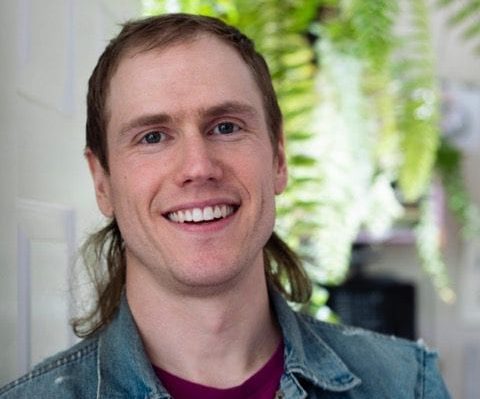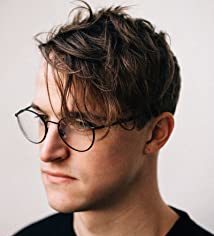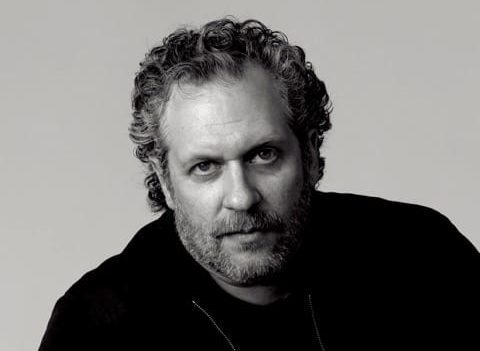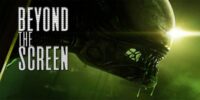I had no idea how much Ultrasound would interest me when it first crossed my radar. As it turned out, it was entertaining, mysterious and thought provoking, so as soon as I’d reviewed it, I sent a request for some time with the team. We battled diary clashes and time zones a few times, and then last week it happened: half an hour with director Rob Schroeder, composer Zak Engel and writer Conor Stechschulte.
After some quick introductions, I opened with a question for Rob. What had it been like making the step up from short films and TV titles to a full length feature? “It was very satisfying,” said Rob. “Doing shorter narrative work felt like a stepping stone to telling a bigger story. For a long time, I’d been looking for the right material that appealed to my sensibilities, so when I came across Conor’s graphic novel, that felt like the right place, and so we got going.”
I’d been wondering how the graphic novel became film material. “It’s episodic,” continued Rob. “There are four books that tell this whole story and when the second one came out, that’s when I was really intrigued, so that’s when I reached out to Conor. The fourth book will be coming out later this year. So he had kind of gotten ahead of the books by writing the screenplay.”
I naturally turned to Conor then. “Rob got in touch just after I’d finished the second book and I had a lot more story in my head that needed to come through. So when he approached me with optioning just the story and get someone else to write the script, I was well…no: I’d really like to write the script and see where it’s going to go. I didn’t fully know where it was going to go and I wanted to be in charge of that journey.”
Did that mean the story was a little different in the film to the books? “Well a little different,” answered Conor. “Really there’s just more story in the books, but they’re pretty close.”
“Books are usually better,” Rob added modestly. I’m not so sure that’s necessarily the case: some favourite graphic novels of mine are the Battle Royale series, made up of 15 volumes—when they are reduced into one film, what you get is neither better nor worse, but a different perspective on the content.

“It was a fun challenge,” Conor continued, “to go from the monomaniacal art form of writing and drawing your own book to writing a script where you’re inviting dozens of other people to come into the story and collaborate. It was a really rewarding experience for me.”
This had been Conor’s first experience of the film industry, so I asked whether he had any lessons to pass on to other newcomers. “I think it would be that you have to figure out what’s important about the story which must get into the script and what can be left open to interpretation or collaboration. When I first started adapting it, I wrote it like I wrote the comics: every time a character scratched their face or blinked; then I realised it was too much and I had to allow space for a performance to happen. That was the big lesson: allowing the air for others to do their work too.”
Ultrasound was Rob’s directorial feature debut, and he had the good fortune of a premiere at Tribeca; I asked what that had been like. “It was tremendous. There had been a lot of great festivals that happened during the pandemic and having an in-person premiere was very special. We’d finished filming during the first week of March and never even had a wrap party or got together all in the same place, so for many of us this was sort of a reunion and some of us met for the first time at Tribeca: coming together in New York was very special.”
I really loved the way the sound and music had been used in the film, the changes of tone and style. I asked whether those concepts developed together, or whether it came first from Zak. “Rob and I had a lot of conversations early on about how he wanted sound used in the film,” answered Zak. “And of course a lot of it came straight from Conor’s book. The idea of sound being an active character came straight from Rob and it’s something I took early on into musical exploration. Rob shared an enormous list of musical references that was so useful: early electronic music, electronic music from the 1970s, they were hugely inspiring. If you start talking about ‘electronic music’, that can mean so many things, so Rob did a lot of work and was a great communicator in asking for things like an electronic score that would guide the story however the music needed to (which was a little more than usual, not to give anything away). Honestly, then to introduce me to some music I’d not listened to before: Mort Garson’s album Plantasia was a huge influence for me, and I still listen to it and love it. It’s music for plants and it felt so apt because of how music (or sound) is subconsciously suggesting in Ultrasound.”

Rob came in here too: “something interesting happened with our sound designer, Bobb Barito in New York, as the music and sound design started coming in. There were full sequences and I wasn’t sure who was making what at some point: there’s a lot going on with music and even animal sounds.” To me, watching (and listening) from an audience point of view, it had seemed that special effects, sound design, editing, and score were all blended together: I couldn’t tell whether they were developed in parallel or if all these elements were pieced together afterwards. “Bobb and I had several conversations,” said Zak, “though the music was already in development by the time that started: we certainly discussed how to blur the line between what is considered music and design, because this line does get blurry in this film. I’ve heard people talk about a moment of sound or a moment of music, not knowing if it’s my work or Bobb’s work, because it really does start to blend together. I think that’s the success of the film, and the success of Bobb as a great collaborator: I tried to leave room and certainly loosen up—like what Conor said about not including every gesture—in some parts I recognised there needed to be more sound here, but that’s a different world of sound; so we were lucky to have Bobb, who’s incredibly talented.”
Following the point about “leaving room”, I asked about the positioning and use of silence within Ultrasound; and there actually wasn’t very much at all. “Definitely,” said Zak. “Brock Bodell, editor and producer on the film, he and I know one another and I had spoken to him and Bobb about how the story and editing were working, and how the sound needed to work. Brock comes from a history of music editing, so he has a talent in terms of placing a rough music edit against picture; I came into a great template that Bobb and Brock assembled together to edit, so we had some transparent conversations along the lines of ‘this works, this doesn’t work, we need music here, maybe not” so there was a lot of thought about where silence and music should go, even before I got involved. I was supported when I had to make those decisions by people who had thought about it a lot.” Rob added, “right out of the gate, particularly with the title Ultrasound, we knew there was going to be a lot of music and sound design, so we came at it with that in mind: the sound would be a character and there would be a lot of it in honour of that title.”
Of course, in a set of books, there is no sound, so I asked Conor if (as the author) he was happy with the outcome. “Yeah, it was awesome for me,” said Conor. “It’s funny how the books, of course are a silent medium, so I think I was thinking along the same lines. Rob and I talked a lot when we were developing the script, and we share a lot of the same tastes in early electronic, “Kraut rock”, cosmic German music and so on; and it was amazing to see it come to life. And I was just telling Zak that I’m staying with my in-laws down in Texas at the moment, and my mother-in-law was like ‘this sounds like Conor’s kind of music’, and yeah right! Those discussions were happening after my involvement in it, and I didn’t get to see it then until the result, and I thought all the work that went into it was incredible.”

I wrapped up the topic of sound with a somewhat cheeky question, asking Zak if he had come across any sounds that did indeed have a hypnotic effect. “So, sure, there is a reality to sound having a physical or mental affect on an individual: it’s as simple as music being able to affect someone’s mood. In terms of research into actually weaponising sounds or causing audience members to fall under a state of suggestion, well, I won’t say. [Then his straight face cracked up] You could be under a state of suggestion now if you’ve watched the film. But no, it was something we discussed and it was something we used as a tool in storytelling and helping to bridge things that on first watch may seem narratively disparate, and then on second watch you realise oh: there were breadcrumbs all along. So that line of literal tones in the film and instrumentation in the score that ties it all together: that was the extent of influencing hallucinatory or hypnotic tones.” I certainly found Ultrasound to be thought-provoking: if mood is being affected by things we hear, we wouldn’t necessarily be aware of it, and that came across as a warning from the film.
Turning to Rob again, I mentioned that by the end of the film I had The Manchurian Candidate firmly in my head, and I asked whether that had been intentional. “When I starting delving into Conor’s four-book story, that was a film that I went to, because I love that movie. There are so many themes and parallels there, though that film does have more to do with politics (ours has some too). I really love all of his early work, and that one is something special.”
When I rewatched Ultrasound to prepare for this interview, I sat down to watch it with my fourteen-year-old son. He wanted to know—as a fellow writer—where on Earth Conor’s ideas had come from. “A lot of different places. Probably the oldest originating kernel was a hypnotism show at my high school when I was like 16 and being really disturbed by seeing some of my friends being manipulated into doing something they weren’t aware they were doing. That was the first time I began to understand the way our brains and our psyche are a little more mechanical and manipulatable than we would maybe like to believe. Then the idea of the trapped motorist came when I was on a cross-country trip in 2011. I remember the first sketches for the opening scene with the tyres blowing out came from sitting in the front seat in the remote areas of America: if someone were to pop our tires, we’d be at the mercy of whoever was closest to lend help. Those two things gave the spark. The other things came from the way when you’re working on a project you just let life in: there is a lot of stuff from my wife’s and my friends’ pasts that are mixed in there too.”
I didn’t want to bring the conversation to a close, but needs must; so I asked what was next for each of these three. Conor first: “I’m working on bringing together all four volumes as a collected edition, so I’m thinking hard about how much I want to fix, how much I want to tidy up: that’s a big challenge. Then there are a couple of other comic ideas I’m working on but haven’t finished. Then, Rob and I have a couple more film collaborations in the works.” Zak followed: “I’m scoring a new feature, a horror/psychedelic/naturalistic film directed by Dalila Droege, conceived and shot during the pandemic.” (On that note, I had to recommend Wheatley’s In The Earth, for its similar setting and use of sound.) Lastly Rob: “I’ve been bouncing ideas around with Conor, as he mentioned, and I have a real fascination with pulp horror as well. I’d like to stay in the genre and make another film soon.”
If you enjoyed this interview, be sure to check out some of our others!
Interview: Karina Michel On Producing, Mental Health, and the Pleasure of Podcasting
Interview with Mani Nasry: Star, Producer, and Director of We
Interview with Nina Kojima On Her Documentary Brexit Through the Non-Political Glass


